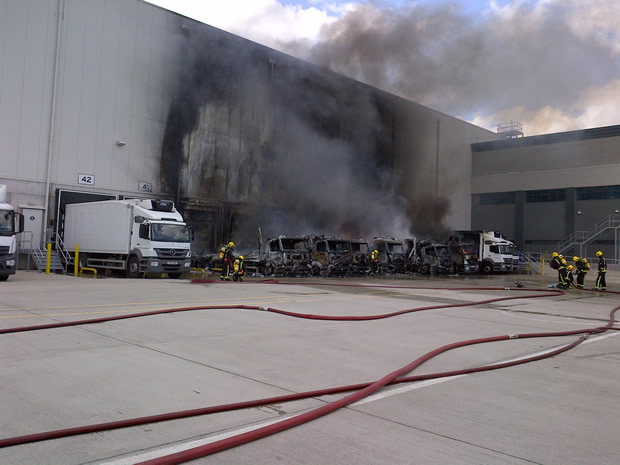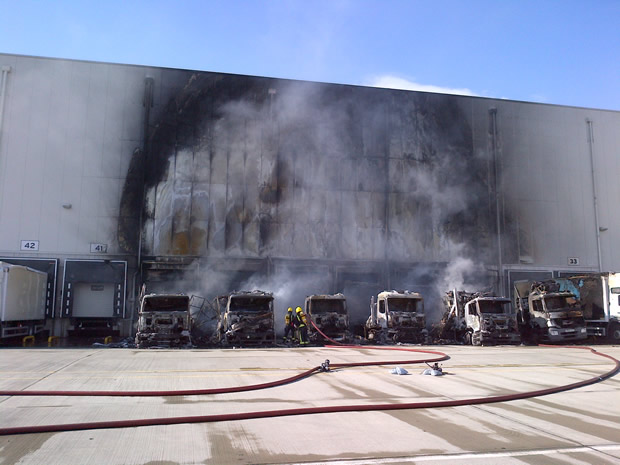The lack of sprinklers in warehouses in England means that hundreds of millions of pounds are lost each year to the economy from fire. Changing the guidelines of the Building Regulations would benefit businesses in the UK

With the amount of problems a business can face following a warehouse fire – from destroyed and damaged stock, lost business to job losses – the importance of investing in reliable, robust fire suppression systems should be widely recognised.

However, current governmental guidance on fire sprinklers in warehouses in England and Wales only applies to premises over 20,000m2 (guidance in Scotland requires sprinklers in warehouses above 14,000m2). Across Europe and competitor economies (including the USA) the regulations apply to much smaller building sizes, which means they are better prepared and more readily able to recover from fires that threaten their businesses.
The automatic sprinkler system, correctly designed, installed and maintained, can contain a fire to a small area within a warehouse and when backed-up by professional fire fighters with access to a good water supply, the chance of a fire getting out of control is minimal. Additional benefits of sprinklers are that they are always “at the ready” even if the warehouse is unoccupied and they provide a reliable fire alarm.
An independent study by CEBR into the financial and economic impacts of fires in warehouses found that warehouses without sprinkler systems cause a direct financial loss to business of £230m per year, causing a loss to the national economy of £190m per year in productivity and impacts to the supply chain.
Moreover, there are wider knock-on effects on local communities due to road closures and redundancies – on average warehouse fires impact more than 20 local business. They also often cause a huge amount of environmental damage, which can be exacerbated when the warehouses that suffer fires store chemicals or flammable materials. For example, some plastics used in goods or packaging materials can decompose and give off toxic by-products when burned or exposed to the high temperatures of a fire.
A clear example of sprinklers preventing what might otherwise have been a much larger blaze occurred at the Sainsbury’s warehouse in Charlton in May. Although six lorries were destroyed and a small part of the 23,000m2 distribution centre was damaged, the London Fire Brigade (LFB) stated clearly that the presence of sprinklers meant that potentially devastating losses to the business were avoided.
Dr. Sabrina Cohen-Hatton, the Incident Command Monitoring Officer at the Sainsbury’s fire, said that “The building construction involved sandwich panels which can be extremely hazardous as some types allow fire to spread quickly. The danger with this type of construction is that the fire can rapidly spread to areas within the walls meaning the spread can’t be seen from the outside. Fortunately this panel had superior fire resistance properties, and backed by the sprinkler network, we managed to contain the fire to a small proportion of the building.”
She added, “Dealing with these sorts of fires quickly and decisively is important for several reasons. It’s important for business continuity as the damage is minimised. This means that the business can be up and running again quickly, and often means that less stock is destroyed or ruined in the fire. The economic and social impact to the local community is also vital to consider, as a quickly suppressed fire means minimal disruption to those working and living in the area”.
Deputy Assistant Commissioner at LFB Mark Andrews said: “There is absolutely no doubt that in this case the sprinkler system, along with the quick actions of our crews, prevented a much more serious fire from spreading any further into the depot and causing potentially millions of pounds worth of damage to both the building and stock inside”.
“This incident highlights the clear benefits of sprinklers to businesses and we would urge all companies to install them. As well as being potentially life-saving devices, sprinklers and other fire suppression systems help with business continuity by minimising disruption and allowing businesses to get back to normal as soon as possible.”
However, it’s not just large warehouses that are at risk.
A serious fire starting in a single warehouse on the Perivale industrial site in West London in July required 20 fire engines and 120 firefighters to control. It could have been more effectively supressed if fire sprinklers had been installed, instead of destroying the whole industrial site and causing one of the biggest London fires in a long time.
Even though the warehouse was a relatively small building and far below the size threshold to require the installation of a sprinkler system, the fire still managed to spread throughout the block, causing significant damage to several local businesses.
Station Manager Jeff Lisle of the LFB who was on duty at the scene said: “Crews worked very hard in extremely difficult conditions to bring this fire under control. Firefighters used aerial ladder platforms to tackle it from numerous vantage points and to prevent the blaze from spreading to neighbouring warehouses”.
The difficulty with the current guidelines on fire safety pertaining to warehouses – laid out in Approved Document ‘B’ – is that it is primarily concerned with the life safety impacts of fire, while the economic, social and environmental impacts are not considered. As the document comes up for review in the coming months, it is imperative that the warehouse and logistics industry works together to voice a concern that a revised version of the guidelines advises on installing fire sprinklers in warehouses of smaller sizes, we would argue, from 4,000 m2. This would bring the UK in line with our European neighbours. It would also allow buildings to be repurposed over the course of their life span, and make them more structurally resilient so that they can dramatically reduce the effect of fire and prevent serious economic, environmental and societal losses.




Comments are closed.